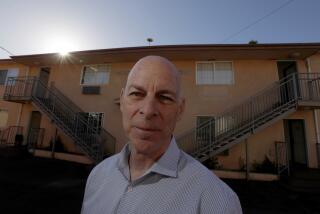PERSPECTIVE ON RESOLUTION TRUST CORP. : Its Mission Isn’t Holding Auctions : With the HomeFed deal, the S & L bail-out agency should turn to making housing affordable, not enriching speculators.
- Share via
The proposed sale of the huge HomeFed Bank to another giant bank is an example of the Resolution Trust Corp.’s misguided “garage sale” mentality. The sale to Great Western Bank should be stopped until the RTC evaluates the impact on Southern California’s economy, jobs and inner-city neighborhoods.
Moreover, the withdrawal Tuesday of Stanley Tate’s nomination to head the RTC gives President Clinton an opportunity to rethink the mission, operation and leadership of this troubled agency. The RTC’s new mission should be turning components of failed thrifts into community redevelopment banks and focusing its resources on creating jobs and improving neighborhoods.
Since its creation in 1989 as the federal agency to oversee the failed savings-and-loan institutions, the RTC has viewed its mission as being the nation’s largest auctioneer. It has received considerable public criticism for paying outrageously high fees to outside attorneys and selling commercial properties to private developers at bargain basement prices, but these problems are only the tip of the iceberg. The bigger problem is how the RTC sells the failed S & Ls and how it disposes of its vast assets, now worth more than $75 billion. This is a particularly important issue in the troubled California economy.
In the 1980s, the Reagan Administration and Congress bowed to the powerful S & L lobby and deregulated the industry, which had previously focused its lending on providing mortgages for America’s home buyers. This opened the door to a decade-long orgy of speculation in commercial real estate. Since 1989, more than 720 S & Ls have failed. The federal bail-out--perhaps the biggest rip-off in U.S. history--has already cost the taxpayers about $85 billion. This money is primarily used to subsidize the purchase of failed institutions, not to protect the average depositors.
Take the case of HomeFed, once one of the nation’s largest thrifts. Like many other S & Ls, HomeFed prospered in the booming California real-estate market, but the thrift was bound to crash from its own mismanagement and high-risk loans. By 1990, HomeFed had lost $248 million and the following year more than $800 million. Federal regulators placed HomeFed in receivership, and the RTC is now in charge of selling the bank, including its real-estate assets, its deposits and its branches.
While it has slightly improved its efforts in the past two years under pressure from Congress and the public, the RTC--including its California office--has mostly ignored Congress’ mandate to turn appropriate properties (such as failed condo projects and apartment buildings) into affordable housing. Instead, it typically pools large numbers of properties and sells them off--often at discounted prices--to speculative investors. Small businesses and community-based housing organizations get pushed out of the bidding war.
Equally important, the RTC has failed to look at the impact on the local economy of selling off entire banks. When the RTC peddles a failed thrift to another bank (often with a taxpayer subsidy), the purchaser usually consolidates the operations of the two institutions. It closes branches and lays off many employees. When it approves a sale, the RTC typically attaches no strings to cushion the blow to the local economy, such as requiring the purchaser to keep existing branches open or to open new branches in underserved neighborhoods.
The RTC is now selling off 119 HomeFed branches, some of which are in Southern California’s poorer neighborhoods. These neighborhoods have consistently been redlined by the banking industry and have seen the closure of many profitable branches, leaving residents at the mercy of unscrupulous check-cashing stores.
The RTC could play an important role in revitalizing these neighborhoods. President Clinton has proposed creating a network of community development banks to help rebuild urban neighborhoods--modeled on the successful and much-heralded South Shore Bank in Chicago. A cluster of HomeFed’s branches could become the basis of a new community development bank for Los Angeles or San Diego. Minority entrepreneurs and community-based development organizations could transform these branches into a vehicle for neighborhood improvement--providing home mortgages, home-repair loans and start-up capital for job creation small businesses--and make a profit.
This creative approach is a business proposition, not charity or social welfare. It would not put any depositors’ savings at risk. It would not cost the taxpayers any more than if it sold all of HomeFed’s holdings to another bank. It would be the most cost-effective option because it would save and create jobs and help rebuild neighborhoods.
There’s an old adage that when you have nothing but lemons, make lemonade. There are many lessons to be learned from the federal government’s misguided deregulation of the S & L industry, the S & L corruption scandal and mismanagement of the RTC.
Rather than repeat those mistakes, the HomeFed sale could be a model of innovation. The RTC should immediately bring together community leaders, public officials and banks’ community reinvestment specialists to put into operation a community development bank that can begin making mortgage loans, hiring neighborhood residents and investing in community enterprises.
More to Read
Inside the business of entertainment
The Wide Shot brings you news, analysis and insights on everything from streaming wars to production — and what it all means for the future.
You may occasionally receive promotional content from the Los Angeles Times.









